| Installing Oracle Personal Edition This guide will help you install the Oracle Personal Edition
database software which is included on the accompanying CD. Once installed,
you will be able to use Oracle in order to study several topics including SQL
queries, active database features, constraints, and database programming.
The database can be used with exercises from the book, course related work,
or personal projects. System RequirementsOracle requires at least the following system configuration: - Windows NT 4.0 or later (Windows NT 4.0/2000/XP Professional)
- 128MB RAM
- 3GB hard disk space available
- CD-ROM Drive
Installation InstructionsIn order to install Oracle Personal Edition, do the following: - Insert the Oralce Installation CD1 into a CD-ROM Drive.
- The Oracle Welcome Screen should appear as below.
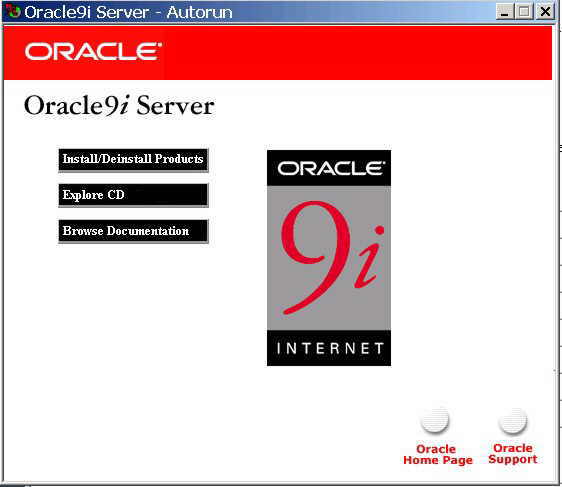 <a onClick="window.open('/olcweb/cgi/pluginpop.cgi?it=jpg:: ::/sites/dl/free/0072465638/57158/one_scr.jpg','popWin', 'width=575,height=504,resizable,scrollbars');" href="#"><img valign="absmiddle" height="16" width="16" border="0" src="/olcweb/styles/shared/linkicons/image.gif"> (24.0K)</a> <a onClick="window.open('/olcweb/cgi/pluginpop.cgi?it=jpg:: ::/sites/dl/free/0072465638/57158/one_scr.jpg','popWin', 'width=575,height=504,resizable,scrollbars');" href="#"><img valign="absmiddle" height="16" width="16" border="0" src="/olcweb/styles/shared/linkicons/image.gif"> (24.0K)</a> If it does not automatically start on your system, or you are installing
it from your harddrive then:
- From the desktop, double-click on the "My Computer" or equivalent
icon to see the drives on your system.
- Double-click on the CD-ROM drive containing the Oracle CD, or go to
the folder that contains the Oralce Installation.
- Double-click on "autorun" folder and then "autorun"
[or "autorun.exe"]
- Click on Install/Deinstall Products. The Oracle Universal Installer will
appear as below.
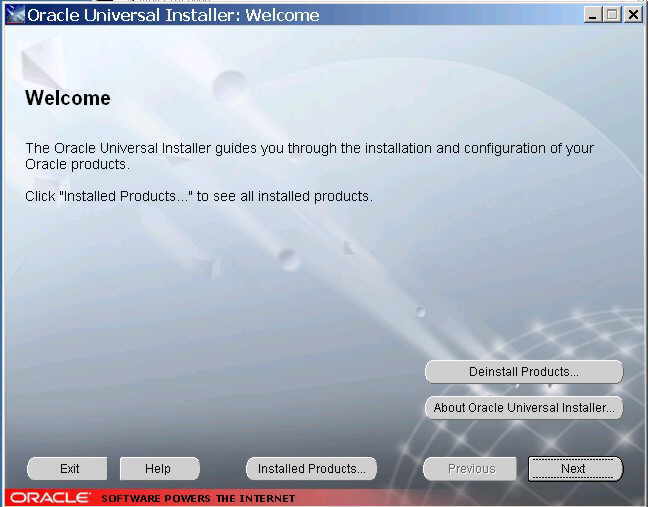 <a onClick="window.open('/olcweb/cgi/pluginpop.cgi?it=jpg:: ::/sites/dl/free/0072465638/57158/two_scr.jpg','popWin', 'width=663,height=523,resizable,scrollbars');" href="#"><img valign="absmiddle" height="16" width="16" border="0" src="/olcweb/styles/shared/linkicons/image.gif"> (30.0K)</a> <a onClick="window.open('/olcweb/cgi/pluginpop.cgi?it=jpg:: ::/sites/dl/free/0072465638/57158/two_scr.jpg','popWin', 'width=663,height=523,resizable,scrollbars');" href="#"><img valign="absmiddle" height="16" width="16" border="0" src="/olcweb/styles/shared/linkicons/image.gif"> (30.0K)</a>
- Click Next. The screen for specifying the installation location will appear
as below. The Source Path field should show the path to the "products.jar"
file in the Oracle Installation. Type DBBOOK_HOME in the Name field. You may
accept the default installation path. If you wish, you may specify another
path in the Destination Path field as long as enough disk space is available
on the drive you select.
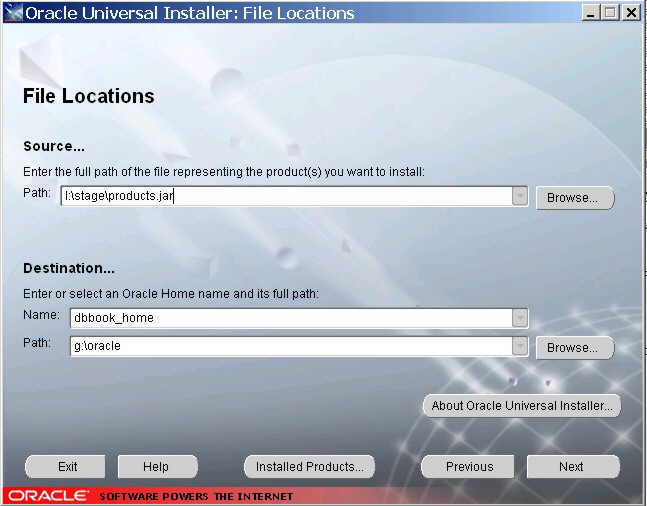 <a onClick="window.open('/olcweb/cgi/pluginpop.cgi?it=jpg:: ::/sites/dl/free/0072465638/57158/three_scr.jpg','popWin', 'width=663,height=523,resizable,scrollbars');" href="#"><img valign="absmiddle" height="16" width="16" border="0" src="/olcweb/styles/shared/linkicons/image.gif"> (33.0K)</a> <a onClick="window.open('/olcweb/cgi/pluginpop.cgi?it=jpg:: ::/sites/dl/free/0072465638/57158/three_scr.jpg','popWin', 'width=663,height=523,resizable,scrollbars');" href="#"><img valign="absmiddle" height="16" width="16" border="0" src="/olcweb/styles/shared/linkicons/image.gif"> (33.0K)</a>
- Click Next. The installer will display a list of products to install. Accept
the default of Oracle 9i Database.
- Click Next. The list of installation types will be displayed. Select "Personal
Edition".
- Click Next. A list of database configurations will appear. Select "General
Purpose".
- Click Next. In the global database name field enter a name (such as dbbook)
followed by your domain. If you do not have a domain from your organization
or Internet access provider, you may choose a domain as you wish. For example,
you could use your name. The fields of your name and domain are separated
by dot (period) characters. A System Identifier will be generated automatically.
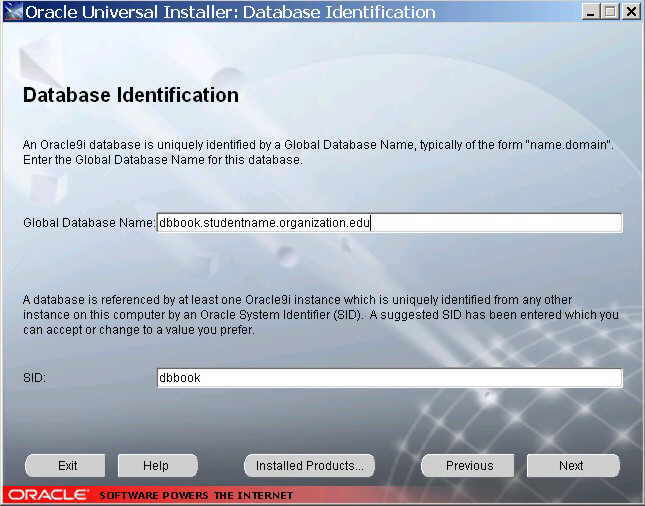 <a onClick="window.open('/olcweb/cgi/pluginpop.cgi?it=jpg:: ::/sites/dl/free/0072465638/57158/four_scr.jpg','popWin', 'width=663,height=528,resizable,scrollbars');" href="#"><img valign="absmiddle" height="16" width="16" border="0" src="/olcweb/styles/shared/linkicons/image.gif"> (38.0K)</a> <a onClick="window.open('/olcweb/cgi/pluginpop.cgi?it=jpg:: ::/sites/dl/free/0072465638/57158/four_scr.jpg','popWin', 'width=663,height=528,resizable,scrollbars');" href="#"><img valign="absmiddle" height="16" width="16" border="0" src="/olcweb/styles/shared/linkicons/image.gif"> (38.0K)</a>
- Click Next. You will be prompted to enter a location for data files. You
may accept the default or specify another location such as a different disk.
- Click Next. You will be asked to chose a character set. You may accept the
default character set.
- Click Next. An installation summary will appear.
- Click Install. Files will be copied to your computer, which will likely
take some time. You will be prompted to enter disk 2. Insert the appropriate
CD into the drive and click OK. Do the same for disk 3.
- Click OK. This will dismiss the configuration information dialog
- The SYS password is change_on_install
- The SYSTEM password is manager
- Click on Exit. The installation is complete. You should also exit the Oracle
Universal Installer. Click Yes when it asks if you really want to exit.
Initial ConfigurationYou will want to create a personal account on your system and change the default
passwords. To perform this tasks do the following: - Launch the Oracle Enterprise Manager Console. It can be found by opening
the following menus from the windows start menu: Start > Programs >
Oracle - DBBOOK_HOME > Enterprise Manager Console.
- Accept the default of launching standalone.
- Click OK. It will display the top level database tree.
- Expand the database you created in step 8 of the installation instructions.
You will be prompted for a password.
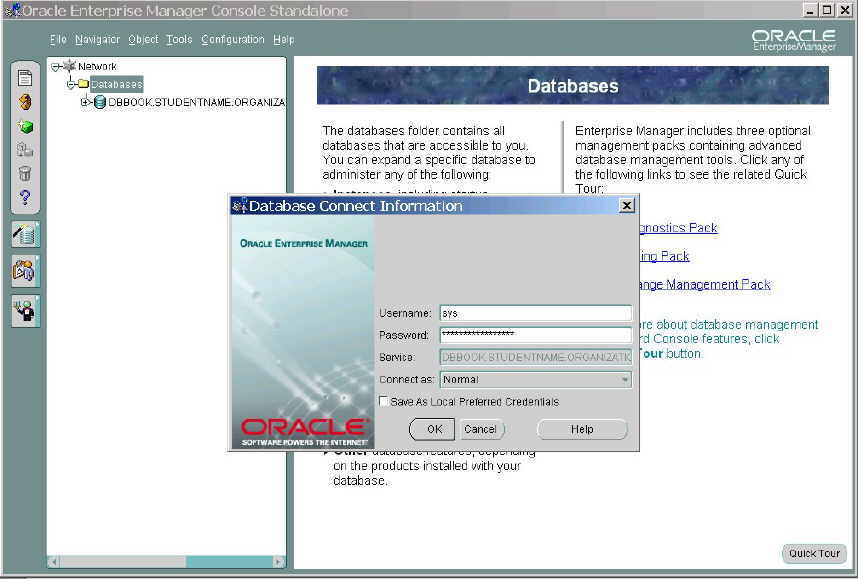 <a onClick="window.open('/olcweb/cgi/pluginpop.cgi?it=jpg:: ::/sites/dl/free/0072465638/57158/five_scr.jpg','popWin', 'width=874,height=595,resizable,scrollbars');" href="#"><img valign="absmiddle" height="16" width="16" border="0" src="/olcweb/styles/shared/linkicons/image.gif"> (54.0K)</a> <a onClick="window.open('/olcweb/cgi/pluginpop.cgi?it=jpg:: ::/sites/dl/free/0072465638/57158/five_scr.jpg','popWin', 'width=874,height=595,resizable,scrollbars');" href="#"><img valign="absmiddle" height="16" width="16" border="0" src="/olcweb/styles/shared/linkicons/image.gif"> (54.0K)</a>
- Enter SYS as the Username and change_on_install as the Password. Select
SYSDBA from the Connect as field.
- Click OK. Part of the database tree will be expanded.
- Expand the Security and then the Users in the navigation pane on the left
of the screen.
- Select the user SYS and enter your preferred password in the Enter and Confirm
Password fields.
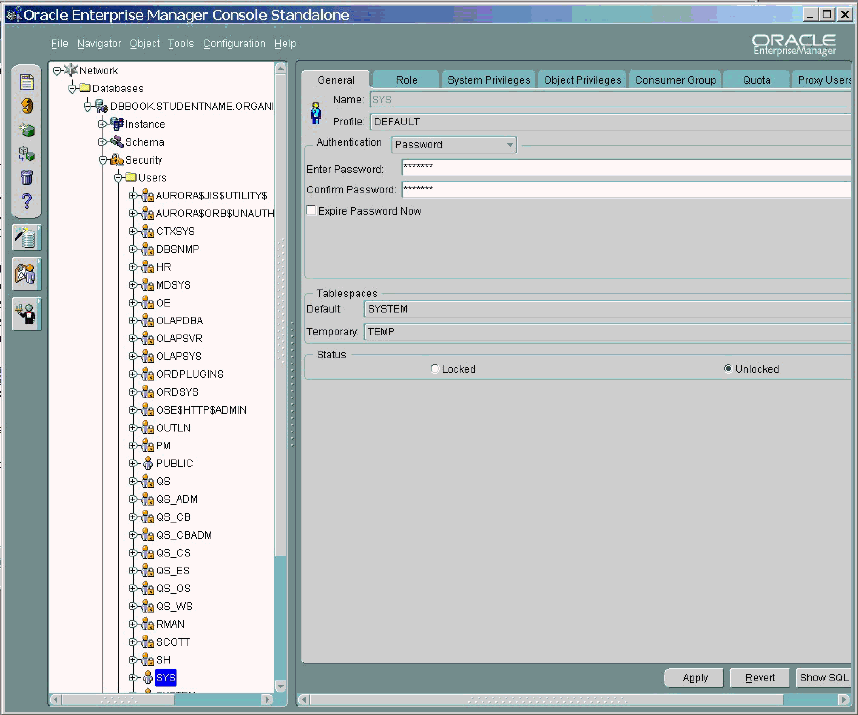 <a onClick="window.open('/olcweb/cgi/pluginpop.cgi?it=gif:: ::/sites/dl/free/0072465638/57158/six_scr.gif','popWin', 'width=874,height=731,resizable,scrollbars');" href="#"><img valign="absmiddle" height="16" width="16" border="0" src="/olcweb/styles/shared/linkicons/image.gif"> (53.0K)</a> <a onClick="window.open('/olcweb/cgi/pluginpop.cgi?it=gif:: ::/sites/dl/free/0072465638/57158/six_scr.gif','popWin', 'width=874,height=731,resizable,scrollbars');" href="#"><img valign="absmiddle" height="16" width="16" border="0" src="/olcweb/styles/shared/linkicons/image.gif"> (53.0K)</a>
- Click Apply. The SYS password has now been changed.
- Repeat 8-9 above for the user SYSTEM.
note: SYS and SYSTEM accounts have database administrator's privilege.
Be careful that you don't forget these passwords.
- Select the user SCOTT and change the Status to Locked. Then click Apply.
- Right Click on the Users Folder in the navigation pane and choose Create.
This will being up the user creation dialog as below.
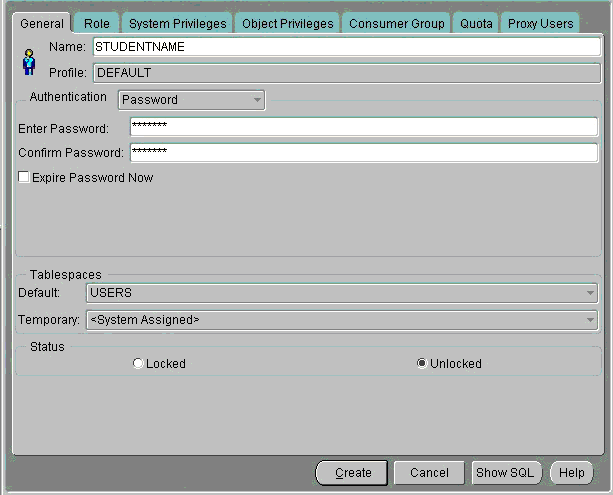 <a onClick="window.open('/olcweb/cgi/pluginpop.cgi?it=gif:: ::/sites/dl/free/0072465638/57158/seven_scr.gif','popWin', 'width=629,height=511,resizable,scrollbars');" href="#"><img valign="absmiddle" height="16" width="16" border="0" src="/olcweb/styles/shared/linkicons/image.gif"> (13.0K)</a> <a onClick="window.open('/olcweb/cgi/pluginpop.cgi?it=gif:: ::/sites/dl/free/0072465638/57158/seven_scr.gif','popWin', 'width=629,height=511,resizable,scrollbars');" href="#"><img valign="absmiddle" height="16" width="16" border="0" src="/olcweb/styles/shared/linkicons/image.gif"> (13.0K)</a>
- Enter a username for your account, such as your name. Enter a password in
the password fields.
- Click on the Role tab and select the DBA Role. Click the down arrow in the
center to grant the DBA role to your account as below.
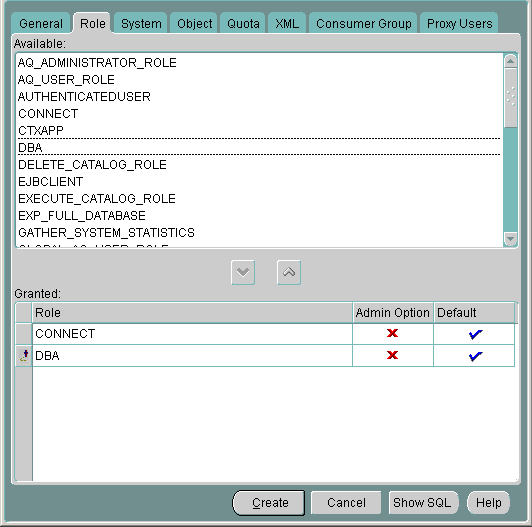 <a onClick="window.open('/olcweb/cgi/pluginpop.cgi?it=gif:: ::/sites/dl/free/0072465638/57158/eight_scr.gif','popWin', 'width=548,height=543,resizable,scrollbars');" href="#"><img valign="absmiddle" height="16" width="16" border="0" src="/olcweb/styles/shared/linkicons/image.gif"> (9.0K)</a> <a onClick="window.open('/olcweb/cgi/pluginpop.cgi?it=gif:: ::/sites/dl/free/0072465638/57158/eight_scr.gif','popWin', 'width=548,height=543,resizable,scrollbars');" href="#"><img valign="absmiddle" height="16" width="16" border="0" src="/olcweb/styles/shared/linkicons/image.gif"> (9.0K)</a>
- Click Create. The account should be created successfully.
Exploring OracleCongratulations you have finished the installation and may now start using
Oracle. For an introduction to basic tasks such as creating tables, running
queries and working with oracle utilities see the Oracle User's Guide on this site.
Version 0.1.1.0 Last Updated: 2002/06/08 by David
Warden
Oracle is a registered trademark of Oracle Corporation. Windows is a trademark
of Microsoft Corporation.
Copyright (C) 2002 McGraw-Hill Companies Inc. All Rights Reserved. |



 2003 McGraw-Hill Higher Education
2003 McGraw-Hill Higher Education






